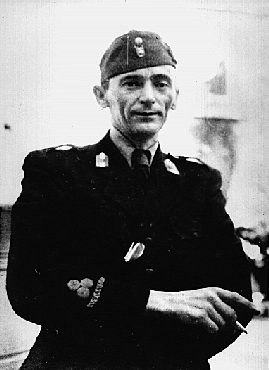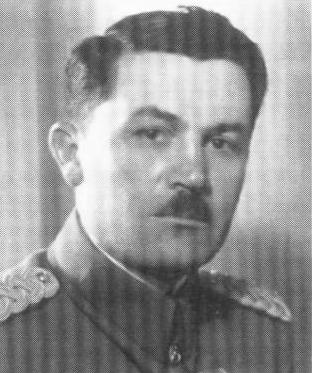
Case White, also known as the Fourth Enemy Offensive, was a combined Axis strategic offensive launched against the Yugoslav Partisans throughout occupied Yugoslavia during World War II. It was one of the most significant confrontations of World War II in Yugoslavia. The offensive took place in early 1943, between 20 January and mid-to-late March. The Axis operation prompted the Partisan Supreme Command to enact its plans to drive toward eastern Herzegovina, Sandžak and Montenegro.

Jure Francetić was a Croatian Ustaša Commissioner for the Bosnia and Herzegovina regions of the Independent State of Croatia (NDH) during World War II, and commander of the 1st Ustaše Regiment of the Ustaše Militia, later known as the Black Legion. In both roles he was responsible for the massacre of Bosnian Serbs and Jews. A member of Ante Pavelić's inner circle, he was considered by many Ustaše as a possible successor to Pavelić as Poglavnik (leader) of the NDH. He died of wounds inflicted when he was captured by Partisans near Slunj in the Kordun region when his aircraft crash-landed there in late December 1942.

The Order of the People's Hero or the Order of the National Hero, was a Yugoslav gallantry medal, the second highest military award, and third overall Yugoslav decoration. It was awarded to individuals, military units, political and other organisations who distinguished themselves by extraordinary heroic deeds during war and in peacetime. The recipients were thereafter known as People's Heroes of Yugoslavia or National Heroes of Yugoslavia. The vast majority was awarded to partisans for actions during the Second World War. A total of 1,322 awards were awarded in Yugoslavia, and 19 were awarded to foreigners.

Operation Rösselsprung was a combined airborne and ground assault by the German XV Mountain Corps and collaborationist forces on the Supreme Headquarters of the Yugoslav Partisans in the Bosnian town of Drvar in the Independent State of Croatia during World War II. It was launched 25 May 1944, with the goal of capturing or killing Partisan leader Marshal Josip Broz Tito and destroying the headquarters, support facilities and co-located Allied military missions. It is associated with the Seventh Enemy Offensive in Yugoslav history, forming part of the Seven Enemy Offensives historiographical framework. The airborne assault itself is also known as the Raid on Drvar.

The Black Legion, officially the 1st Standing Active Brigade, was an Ustaše genocidal militia infantry unit active during World War II in Independent State of Croatia. The legion was formed in September 1941 as the 1st Ustaša Regiment. It consisted largely of Bosnian Muslim and Croat refugees from eastern Bosnia, where large massacres were carried out by Chetniks and to a small degree by the Yugoslav Partisans. It became known for its fierce fighting against the Chetniks and the Partisans and massacres against Serb civilians. The legion's commanders were Colonel Jure Francetić and Major Rafael Boban. It consisted of between 1,000 and 1,500 trained mechanized infantrymen.

Operation Trio was the first large-scale joint German-Italian counter-insurgency operation of World War II conducted in the Independent State of Croatia (NDH), which included modern-day Bosnia and Herzegovina. It was carried out in two phases within eastern Bosnia from 20 April to 13 May 1942, with Ustaše militia and Croatian Home Guard forces taking part on the Axis side. The aim of the operation was to target all insurgents between Sarajevo and the Drina river in eastern Bosnia. These included the communist-led Yugoslav Partisans and Serb nationalist Chetniks. Differentiating between the rank and file of the two insurgent factions was difficult, as even the communist-led insurgent groups consisted mainly of Serb peasants who had little understanding of the political aims of their leaders.

Kupres is a town and the seat of the Municipality of Kupres in Canton 10 of the Federation of Bosnia and Herzegovina, an entity of Bosnia and Herzegovina. As of 2013, it has a population of 5,057 inhabitants, while the town of Kupres has a population of 2,883 inhabitants.

Franjo Šimić was a Croatian colonel, and later general, in the Croatian Home Guard.

Mihajlo Lukić was a Croatian general who began his career as an officer in the Austro-Hungarian Army during World War I, then climbed the hierarchy of the Royal Yugoslav Army, finally joining the Croatian Home Guard during World War II. He was retired in 1943 due to his disapproval of sending Croat volunteers to the Wehrmacht. After the collapse of the Independent State of Croatia, communist authorities sentenced him to 10 years in prison.
Operation Winter '94 was a joint military offensive of the Croatian Army (HV) and the Croatian Defence Council (HVO) fought in southwestern Bosnia and Herzegovina between 29 November and 24 December 1994. The operation formed part of the Croatian War of Independence and the Bosnian War fought between Bosnia and Herzegovina, Croatia and two unrecognized para-states proclaimed by Croatian Serbs and Bosnian Serbs. Both para-states were supported by the Yugoslav People's Army (JNA) and Serbia. The JNA pulled out in 1992, but transferred much of its equipment to the Bosnian Serb and Croatian Serb forces as it withdrew.
The Battle of Livno is the name of several battles fought over the town of Livno during World War II, which changed hands between the Independent State of Croatia and Partisan forces several times.

The Bihać Republic was a short-lived republic that existed between November 1942 and January 1943 in a liberated area of Nazi-occupied Yugoslavia. It was established by the Partisan resistance movement following the liberation of Bihać. Bihać became its administrative center and the first session of the Anti-Fascist Council of the People's Liberation of Yugoslavia (AVNOJ) was held there on 26 November 1942.
Mijači is a village in the Brestovac municipality of the Požega-Slavonia County, Croatia. According to the 2001 census, there were 18 inhabitants in the village. The village is connected by the D38 state road.
The Battle of Logorište was fought east of Duga Resa and south of Karlovac, Croatia, from 4–6 November 1991 during the Croatian War of Independence, between the Croatian National Guard and the Yugoslav People's Army. The ZNG placed the JNA-held Logorište barracks under a blockade as part of the countrywide Battle of the Barracks, which aimed to pin down JNA units isolated in their bases and force them to surrender weapons and ammunition to the ZNG. However, the JNA garrison broke out from the besieged barracks with part of its stored equipment before the ZNG claimed the vacant base. The breakout was supported by JNA units and SAO Krajina units deployed to lift the blockade of the barracks and other JNA garrisons in Karlovac. A battle ensued as the ZNG attempted to contain advancing JNA units, ending with a ceasefire signed in The Hague.
The Battle of Kupres was a battle of the Bosnian War, fought between the Bosnian Croat Territorial Defence Force supported by the Croatian Army troops on one side and the Yugoslav People's Army, augmented by the Bosnian Serb TO on the other at the Kupres Plateau, on 3–11 April 1992. During the fighting on 8 April, the Bosnian Croat TO was reorganised as the Croatian Defence Council. The objective of the battle was to control the strategic Kupres Plateau, a major supply route.

The Partisan Long March was the redeployment of Josip Broz Tito's Partisan Supreme Headquarters and the major fighting elements of the Yugoslav Partisans across the Independent State of Croatia, from south-eastern to north-western Bosnia that commenced in late June 1942. The march followed the first large-scale joint German-Italian counter-insurgency operation in the NDH, Operation Trio, and the combined Italian-Montenegrin Chetnik offensive in Montenegro and eastern Herzegovina.

When World War II started, Zagreb was the capital of the newly formed autonomous Banovina of Croatia within the Kingdom of Yugoslavia, which remained neutral in the first years of the war. After the Invasion of Yugoslavia by Germany and Italy on 6 April 1941, German troops entered Zagreb on 10 April. On the same day, Slavko Kvaternik, a prominent member of the Ustaše movement, proclaimed the creation of the Independent State of Croatia (NDH), an Axis puppet state, with Zagreb as its capital. Ante Pavelić was proclaimed Poglavnik of the NDH and Zagreb became the center of the Main Ustaša Headquarters, the Government of the NDH, and other political and military institutions, as well as the police and intelligence services.
The siege of Rogatica was a joint attack of Partisan and Chetnik rebel forces on Rogatica, then held by the Independent State of Croatia. The siege continued between 13 and 24 October 1941.

The Bihać operation was a military operation conducted by Yugoslav partisans against the Independent State of Croatia (NDH) and Nazi Germany during World War II. The aim of the operation was to capture Bihać and the surrounding towns to connect Partisan held areas in Bosanska Krajina, and Knisnka Krajina. The battle for the city of Bihać lasted from 2 November to 4 November 1942. After capturing the city, the partisans continued to fight in surrounding areas until 15 November. The operation resulted in a major Partisan victory, with Bihać and the surrounding areas being captured, and the NDH suffering significant casualties.

The 6th Proletarian Assault Lika Division "Nikola Tesla" was a Yugoslav Partisan division formed on 22 November 1942. It was formed from the 1st, 2nd, and 3rd Lika Brigades. On 11 November 1943, it became part of the 4th Corps and later a part of the 1st Corps. It operated in Dalmatia until November 1943 when it crossed into Bosnia, later it fought in Serbia and on the Syrmian Front. From October 1944, the 22nd Serbian Kosmaj Brigade also fought as part of the division, and in December 1944 an Artillery Brigade was formed within the division.













